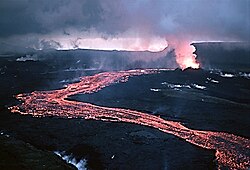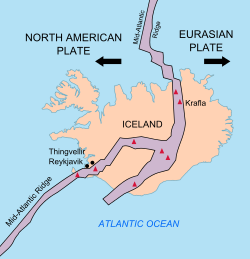Iceland hotspot

The Iceland hotspot is a geologic hotspot. It is partly responsible for the high volcanic activity which has formed the island of Iceland.
Iceland is one of the most active volcanic regions in the world. On Iceland, there are volcanic eruptions about every three years. In the 20th century there were 39 volcanic eruptions on and around Iceland. About a third of the basaltic lavas erupted in recorded history were produced by Icelandic eruptions.
Notable eruptions have included that of Eldgjá, a fissure of Katla, in 934 (the world's largest basaltic eruption ever witnessed), and Laki in 1783 (the world's second largest). In many places, Iceland is covered by glaciers. Several eruptions under ice caps have burst through the ice. The most recent one was in 2010 after the eruption of Eyjafjallajökull.
Iceland's position over the Mid-Atlantic Ridge is partly responsible for this intense volcanic activity. It is not understood why Iceland is an island, but the rest of the ridge consists of seamounts, with peaks below sea level.
Causes
There is discussion whether the hotspot is caused by a deep mantle plume or at a shallower depth.[1]
Some geologists have asked whether the Iceland hotspot has the same cause as other hotspots such as the Hawaii hotspot. They show a clear volcanic track over time caused by the movement of the Pacific Plate over the Hawaiian hotspot, but no such track can be seen at Iceland.
The line from the Grímsvötn volcano to Surtsey may show the movement of the Eurasian Plate and the line from the Grímsvötn volcano to the Snæfellsnes volcanic belt shows the movement of the North American Plate.[2]
Iceland Hotspot Media
References
- ↑ Foulger, Gillian R. 2005. Iceland & the North Atlantic Igneous Province MantlePlumes.org
- ↑ Morgan, W. Jason & Morgan, Jason Phipps 2009. Plate velocities in hotspot reference frame: electronic supplement. In Foulger, Gillian R. & Jurdy, Donna M. Plates, Plumes, and Planetary Processes (P4).



